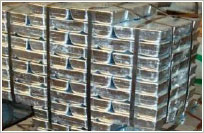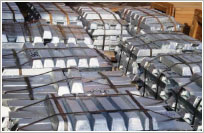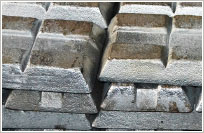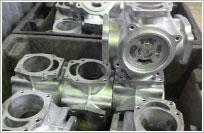Foundry alloys of zinc
- NON-FERROUS METALS
- General information
- About us
- Rolled ZINC
- Rolled zinc
- Zinc ingots TSV00
- Zinc TS0A
- Wire Zinc TS1
- Zinc plate
- Zinc wire
- Seam roof zinc-titanium
- Zinc Sheet
- Zinc Alloy TSAM4-1
- Rolled zinc
- Foundry alloys of zinc
- Zinc alloys
- Zinc powder PTS1
- Zink powder PTS2
- Zinc powder PTS3
- Zinc powder PTS4
- Zinc powder
- Zinc granular
- Zinc Protector P-KOTS (shorted)
- Zinc ingots
- Zinc Protector P-REC (non-disconnectable)
- Zinc protectors
- Zinc ingots
Foundry alloys of zinc
By itself, the zinc does not have the necessary technological properties, which would be used in the foundry industry. Therefore, certain foundries zinc alloys have been developed. Depending on what the parameters should have the alloy in its composition can include magnesium, copper, aluminum, manganese, magnesium, iron, antimony, cadmium, lead, tin. The main alloying zinc foundry additives include copper, aluminum, magnesium and manganese. On the hardness potential, which will have a zinc alloy in the future, the most affected by the copper, iron and magnesium. So often in foundries apply these alloys, as their technical and physical characteristics, they satisfy the requirements of many industries using zinc alloys in its production process. Let us consider how the impact on the various properties of zinc dopants. Basically casting of zinc alloys - ternary, as dopant materials being copper, aluminum and magnesium. Magnesium alloy composed of zinc contained in the minimum amount and greatly reduces intergranular corrosion. However, it significantly reduces the effect of these impurities on zinc, tin or lead. Elevated levels of the alloying element leads to a significant deterioration of the mechanical properties of the zinc alloy. Adding copper casting alloys of zinc metal strength increases, and also increases the flowability during casting. However, the copper additive significantly reduce the service life of the finished parts, since over time they change in size (increase) due to the aging of the metal. The presence of aluminum, which is often added to a zinc alloy casting, substantially reduces the solubility of iron in smelting. It is the same as copper can increase the strength of the alloy and its fluidity. It should be noted that in addition to the metals listed in the casting of zinc alloys often added manganese, which lowers the impact resistance, and also increases the ductility of the material, and nickel, metal enhancing resistance to steam and hot water.
|
|
|
|
|
|
|
|
|
|
|
|
|
|












